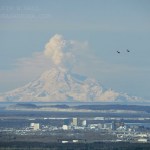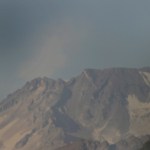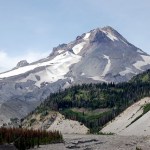
The clock is ticking for the new dome growing at Redoubt to collapse. What will happen if/when it does collapse? Good question!
The new dome at Redoubt. Image courtesy of AVO/USGS, taken by Game McGimsey, April 30, 2009.
Most likely, the following will occur:
First, extrusion of lava will cause the dome to over-steepen, precipitating the collapse (although a large seismic event could also trigger collapse as well). An excellent example of this is the spine that grew at Mont Pelee on Martinique in 1902 before the famous eruption that destroyed St. Pierre and killed >30,000 people.
When it…
Chaiten erupting in May 2008. Image courtesy of ONEMI.
Speaking of anniversaries, this weekend is the one-year mark for the Chaiten eruption (in spanish) in Chile, the first eruption at the volcano in ~9,000 years. Yes, indeed, the rhyolite eruption that caught most everyone by surprise is still going strong one year later, with two domes growing within the caldera (in spanish). The eruption produced some of the most impressive and sustained ash columns in years (see below) - climbing to 16 km/9 mi, abundant lahars and pyroclastic flows from the emergence and growth/collapse of the domes and…
For those of you who might not be paying as close attention to Redoubt now as in the past, this is the latest from AVO:
Redoubt's 2009 eruption continues and appears to be gaining intensity. Seismic activity has increased markedly in the last 24 hours, showing stronger volcanic tremor and more frequent rockfall events. Minor emissions of ash have also been visible in webcam views during this time period. Steam emissions in particular have become more vigorous over the last 2 hours, with a steam plume now reaching approximately 18,000 feet above sea level.
Are we headed to a dome collapse in…
Mt. Barujari erupting in 1994. Image courtesy of Vulkaner.no.
Sometimes it is hard to appreciate how many volcanoes lie within Indonesia. However, within the last few weeks, no less than four Indonesian volcanoes have been put on alert to eruption or shown increased signs of activity - Slamet, Kirinci, Anak Krakatau and now Mt. Rinjani (above).
UPDATE 5/3/2009 11AM (Pacific): The volcano is erupting according to the Jakarta Globe. Seems like the activity so far is confined to small explosions emitting ash and gases. More info as I find it.
Rinjani is a popular tourist destination on the…
Happy Birthday, Eruptions!
Well, this definitely snuck up on me, but today marks the one-year anniversary for Eruptions! On May 1, 2008, I started this little blog and if anyone told me that a year later I'd be paid for the gig and getting 50,000 views a month, I would have called them nuts.
So, thank you to all the Eruptions readers and commenters - there are too many to list here, but we've had a blast discussing the eruptions at Chaiten, Redoubt, Hunga Tonga Hunga Ha'apai, Huila, Kasatochi and many many more. It is these discussions that make me realize that this blog is useful, especially…
Redoubt in April 2009 with Anchorage in the foreground (along with two F-22 Raptors). Image courtesy of Calvin Hall.
It has been quite some time since I talked about Redoubt, mostly because the volcano has been in the "slow extrusion of a dome" mode that has not generated much beyond impressive steam (with some ash) plumes. The volcano continues to stay at Orange/Watch status. I did glean a few interesting facts and speculations about the future at Redoubt from Dr. Jake Lowenstern of the USGS the other day, including:
The new dome growing on the volcano has more room to expand than the 1989-…
Volcano monitoring. Image courtesy of the USGS.
Last night I had the opportunity to see a talk given by YVO Scientist-in-Charge Dr. Jake Lowenstern as part of the Volcanological Society of Sacramento meeting and he gave a great talk on the state of volcano monitoring today in the U.S. He laid out a lot of details concerning the Volcano Hazards Program of the USGS and I thought I'd share some of them so we can all have an idea of the ups and downs of the VHP these days.
First off, nothing says fun like the U.S. Volcano Status Map! Apparently the dreaded watch "eye" was not meant to be a…
The weekly USGS/SI roundup is out. Highlights (beyond Slamet) include:
Explosions (some heard 25 km away) and incandescent blocks that started fires at Galeras, Colombia.
Ash and tephra being thrown tens of meters into the air and a 4-m tall spatter cone being built at Pacaya, Guatemala
Also in Guatemala, Santa Maria's Santiaguito dome produced ash plumes and explosions.
Steam, ash and sulfur odors from the continuing eruption at Redoubt, Alaska.
Increased seismicity, steam and ash plumes along with a thermal anomaly at El Reventador in Ecuador
Descabezado Grande, Chile showing increased fumarolic activity in 2009.
Well, if they didn't have enough already between Llaima and Chaiten, another volcano in southern Chile has started erupting. Descabezado Grande (roughly translated: "The Big Beheaded One") has erupted or is showing of eruption (in spanish and NOTE that the picture in the article is of Llaima, NOT, I repeat, NOT Descabezado Grande ... grrr) but details are scant on the actual activity. However, scientists from the SERNAGEOMIN are headed to the area to evaluate the volcano - hopefully the reports are accurate. So far,…
This is another busy Wednesday for me as the Geology Dept. at UC Davis will be hosting Dr. Jacob Lowenstern, USGS scientist and director of the Yellowstone Volcano Observatory. He will be giving the weekly seminar, along with another talk in the evening at Sacramento State as part of the Volcanological Society of Sacramento meeting (which is open to the public for those of you around Sacramento). I'm especially excited for the evening talk entitled "Domestic volcanic unrest and activity in 2009: Kilauea, Redoubt, Yellowstone and Washington, D.C.". I'll be sure to report any fun tidbits.
For…
Mt. Pinatubo, Philippines taken by STS-050 in July 1992. Image courtesy of the NASA Earth Observatory
Few websites offer so many unique views of active volcanism than the NASA Earth Observatory. That is why I'd like to wish the EO a happy 10th birthday. The website first came online April 29, 1999. Keep up the good work and here's to more stunning volcano images (like the one above of Mt. Pinatubo) to come!
One of the best resources for volcanism on the planet needs someone to run it:
National Museum of Natural History, Smithsonian Institution,
Washington D.C. anticipates hiring a distinguished scientist to become
the Director of the Global Volcanism Program and to conduct a research
program in volcanology in the Department of Mineral Sciences. As a
Federal employee, the successful candidate will be expected to serve
as Curator making major contributions to the field of volcanology
through research and publications, and to oversee the Global Volcanism
Program's documenting and reporting of the…
Shiveluch volcano in Russia. Image courtesy of KVERT.
Over this past weekend, Shiveluch in Kamchatka experienced a plinian eruption, producing a 7-km / 23,000 foot ash column. The NASA Terra satellite caught a great image of the ash plume over the snowy landscape of the Kamchatkan Peninsula on April 26, 2009. KVERT issued these comments on the current eruptive activity:
Seismic activity of the volcano slightly decreased but continues to
remain at high levels. A continuous spasmodic volcanic tremor and
series of weak shallow events continue to registering at volcano at
present.
According to…
Mt. Slamet, Indonesia, with agricultural fields in the foreground.
I'll be brief, mostly because I'm still lost in a haze of jetlag and allergies, but ...
Mt. Slamet on the island of Java in Indonesia is showing signs of a "major eruption". Preparations have begun by the Indonesian government to evacuate people in the event that the volcano erupts, however, it is unclear when that might be. Agus Budianto, head of the volcanology unit at the Bandung, West Java-based Volcanology and Disaster Mitigation Agency, said this about the current activity at the volcano:
"Even though the earthquake…
Back in the days when Eruptions was on Wordpress, I held a vote about what volcano should be the next to be profiled on this blog. The winner was Mt. Hood in Oregon, and after much waiting, the profile is here. I will actually be out of town until Monday doing some house shopping in this little town. Enjoy this look at one of the most picturesque (and hazardous - #4 in fact) volcanoes in the lower 48 states.
VOLCANO PROFILE: MT. HOOD
Mt. Hood, Oregon in August 2008 taken by Erik Klemetti.
Location: Oregon, U.S.A.
Height: 3,426 m / 11,240 ft
Geophysical location: Along the Cascade arc where…
Satellite image of the island of Tenerife with the main vent of the volcano (El Teide) in the central part of the island.
I will be out of town for the next few days, so I thought I'd leave this thread for breaking volcano news that any of you Eruptions readers notice.
However, I couldn't pass up the opportunity to point out some abysmal science journalism before I go. I mean, I shouldn't have been surprised considering this is from the The Sun(UK), but, come on, could you at least put some effort in?
The article in question pertains to the recent controversy about the level of danger people…
UPDATED 3:30PM Pacific: The Associated Press has put up some silent video of the lava flows reaching the ocean at night
The Geophysical Institute in Ecuador is reporting that the eruption at Fernandina in the Galapagos has intensified over the last 24 hours. Heck, the image accompanying the report looks downright apocalyptic:
Now, I'm actually not entirely sure what is being shown in this image. There is no caption, either. My guess is that this is an ocean entry for one of the lava flows, considering the steam and what looks to be water in the foreground. Of course, I have no idea if the…
Has a week gone by already? It is time for another USGS/Smithsonian GVP Weekly Volcano Activity Report.
Highlights (beyond Fernandina, Pagan and Redoubt) include:
A new underwater eruption at NW-Rota 1 in the Mariana Islands.
Increasing seismicity and incandescence from the rhyolite domes forming at Chaiten, Chile.
A spike in sulfur dioxide emissions from Kilauea, Hawai'i to 700 tonnes/day (up from a 2003-07 average of 150 tonnes/day).
4.5-7.5 km / 15-26,000 foot ash columns produced at Shiveluch in Kamchatka from new lava dome.
Continued dome growth and ~6 km / 26,000 foot ash columns from…
Mt. Baker in Washington. Image taken by John Scurlock.
Eruptions reader Robert Somerville brought to my attention the Mount Baker Volcano Research Center, a "clearinghouse for research on Mt. Baker" in Washington state. The center is a non-profit organization that is affiliated with the Geology Department at Western Washington University - and from the looks of the website, they've already done a great job in compiling a lot of information about Mt. Baker, including an excellent eruptive history of the volcano. Mt. Baker is one of the most active Cascade volcanoes, with active fumarolic…
Fernandina in the Galapagos erupting in April 2009. Image courtesy of NASA.
The latest reports about the ongoing eruption at Fernandina are both coming and going. Reports from officials in the Galapagos National Park suggest that the eruption was become more intense (in spanish), while later reports from the Geophysical Institute in Ecuador say that the eruption is waning. Both reports might be true and reflect the volatile nature of the eruption, but overall it seems that the wildlife (that probably is used to this sort of thing anyway) hasn't been effected too much by the eruption.



